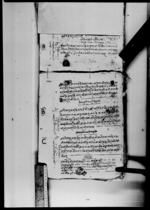A copy of a lālamohara from King Gīrvāṇayuddha reconfirming Viṣṇu Sāhī as being in charge of the sword of the dasaĩghara at Nuvakot (VS 1864)
ID: K_0029_0033C
Edited and
translated by Astrid Zotter
Created: 2021-02-08;
Last modified: 2021-03-22
For the metadata of the document, click here
The accompanying edition, translation/synopsis and/or commentary are available under the terms of the Creative Commons Attribution-ShareAlike 4.0 International License
Abstract
This copy of a lālamohara from the king, who according to the date must have been Gīrvāṇayuddha, confirms that Viṣṇu Sāhī is to be in charge of the sword of the dasaĩghara of Nuvakot. He is entitled to enjoy the income from the trust (guṭhī) land specified in the details.Diplomatic edition
[114r]
1⟪६६नं⟫1⟪जैसीकोठावाट2नकलवमोजिंनकलदुरुस्तछ⟫1आगेवीष्णूसाहीके•नुव़ाकोट्दसैघर•कोष़ाडोसमातनके•तीम्रा
2संतानछोडी•अरुलाईनदिनु•भनीगर्य़ाकोरहछ•तेहीवमोजिं•
3हामीलेठामीवक्स्यौ•आफनाषातीरज्मासंगषाडाकातहलमारु
4जुरही•हाम्राजैमनाई•तपसीलवमोजिंको•षेत•गुठीजानीभो•
5ग्य•गर
6तपसील
[table1]
| 1 | नुव़ाकोट्कोडमकीतारमुरी• | ५० | चर्कुष्णामुरी | २० |
| 2 | रातमाघामुरी | २० | डाङमैमुरी | १० |
| 3 | त्री•वैनीमुरी | ५० | नीलीवोकधर्याडींरोपनी | ११ |
| 4 | ज्माषेट | १ |
7इतीपौषसुडी१रोज[?][Unknown seal 1][Unknown seal 2]
Translation
[114r]
[Addition in the left margin:]
no. 661
From the Jaisīkoṭhā office:
The copy is true to the copy.
[Main text:]
Āge: To Vīṣṇū Sāhī.
It appears that it has been ruled that, except for your offspring, [you] must not let others touch the sword of the dasaĩghara of Nuvākoṭ. We support [continuing on] in accordance with this. Be present for services requiring the sword, celebrate our triumphs, consider the field specified in the details as [your] guṭhī and enjoy it, being mindful of your duties.
Details (tapasila)
[table1]
| 1 | [at] Ḍamakītāra2 in Nuvākoṭ, murīs | 50 | [at] Carkuṣṇa,3 murīs | 20 |
| 2 | [at] Rātamāghā,4 murīs | 20 | [at] Ḍāṅamai,5 murīs | 10 |
| 3 | [at] Trīvainī,6 murīs | 50 | [at] Nīlīvoka,7 plot for erecting a building (ghaḍerī), ropanīs | 11 |
| 4 | Total [land] in khetas8 | 1 |
[Wednes]day, the 1st of the bright fortnight of Pauṣa.9
[Unknown seal 1]
[Unknown seal 2]
Commentary
Another copy of a lālamohara with what seems to be the same text, except for the date and some figures in the tapasila, is extant as K_0002_0002C. This copy gives the date of issue as the 15th of the bright fortnight of Māgha in VS 1864, roughly one and a half months after the present document. In one or both of these dates some errors seem to have occurred when they were copied (see note on the date of the present document above). Likewise, and as also detailed in the notes to the translation, there must have been confusion over the names of the individual land tracts and the calculation given in the details. As the present document according to the marginal note is a copy of a copy it is impossible to infer the original readings in these cases.
The document reconfirms the person in charge of a sword in the dasaĩghara of Nuvakot. This seems to concern the practice of worshipping and parading royal swords during the autumnal Dasaĩ festival (see Zotter 2018: 288 and passim). The person appointed seems to have been the dvāre of Nuvakot. The roles and duties of the dvāre, in the case of Nuvakot a kind of stadtholder with administrative and ritual rights and duties, were fixed when Pṛthvīnārāyaṇa Śāha shifted the capital to Kathmandu.10 In Śaka Samvat 1690 (1768 CE) Naijarāma Medasi Sāhi was appointed to speak the formulas of ritual commitment (saṃkalpa) in the procession of the goddess (devījātrā) and during Dasaĩ, replacing family members of the kings of Nepāla, i.e. the Malla kings, in these roles.11 The text specifies: "From now on you should perform the worship procedures and saṃkalpas we have to perform in the procession of Śrī Bhairavī and in the sword procession of Śrī Tulajā during Dasaĩ there. After your demise your descendants should perform [these tasks]."12 For these duties of what the text calls a "royal guṭhiyāra" (rāja guṭhiyāra) an emolument (jāgira) in land was specified. The role of the dvāre as representative of the king in rituals persisted down to the modern period, with him appearing as carrier of the royal sword and speaker of the saṃkalpa formulas (Gutschow 2011: 1: 157–159). Moreover, the "house of the Dvāre ... as representative of the king, marks almost exactly the central position between the house of the royal deity and the palace" (ibid.: 1: 159).
Given this evidence it seems likely that Viṣṇu Sāhī, the addressee of the present document, was a descendant of Naijarāma Medāsi Sāhi and had been the dvāre of Nuvakot. The duties relating to the sword of the dasaĩghara that the documents refer to are likely those Pṛthvīnārāyaṇa's charter refers to as the "worship procedures and saṃkalpas we (i.e. the king) have to perform in the sword procession of Śrī Tulajā during Dasaĩ" (dasaĩmā śrī tulajākā ṣaḍgajātrāmā hāmile garnu parne pūjāvidhi saṃkalpa), even if we cannot be absolutely sure. Another possibility—less likely but not completely impossible—would be that under the Śāha kings a new separate dasaĩghara had been erected at Nuvakot, as was done in the palace of Kathmandu (see K_0625_0039) and Viṣṇu Sāhī was in charge of a sword different from the one belonging to the Taleju temple and used for the Malla kings.

